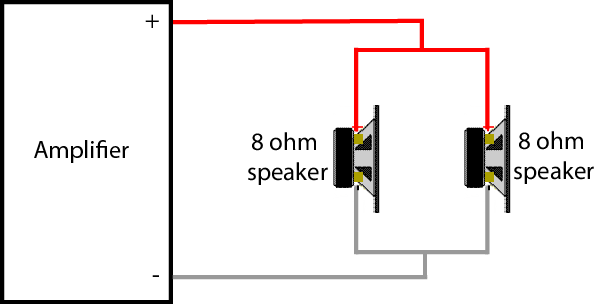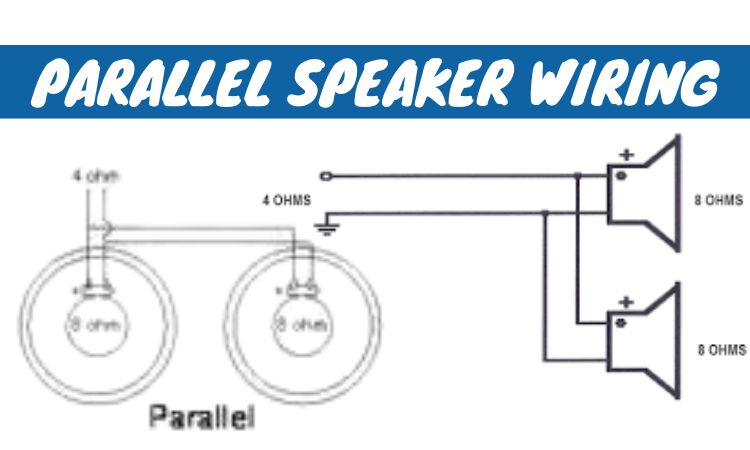Last Updated on 2 years by On Trends Gear
Wiring speakers in parallel is a common way to increase the sound output of an audio system.
By Parallel Speaker Wiring or wiring multiple speakers in parallel, the total wattage of the system increases, and the sound output are amplified.
However, the wattage of the individual speakers does not increase when wiring in parallel,
So it is important to understand how this wiring affects the total power output of a system before making any changes.
Table of Contents
What is Speaker Parallel Wiring?

When connected in parallel, adding new speakers or connecting them is a piece of cake.
A parallel connection might be employed if there is a need to lighten the load on the circuit as a whole.
The most fundamental type of electrical circuit is one that is composed solely of wires.
Because of this, a lot of people are interested in gaining knowledge regarding parallel speaker wiring.
Where exactly does the parallel mechanism work its magic?
They join all of the positive electrical lines to the other negative leads in the circuit.
A parallel connection is the simplest way to wire speakers since all that has to be done is add the positive connection of the new speaker to the existing positive leads and the negative connection of the new speaker to the existing negative leads.
Even though adding speakers through a parallel connection is a simple process, as was said before, it reduces the overall resistance.
If you use the law of Ohm, you will see that this increases the amount of electrical current.
This is because connecting additional speakers lowers the overall resistance, which in turn causes the amplifier to demand more power.
How Does Parallel Speaker Wiring Affect Speaker Volume?
Once you get your head around series and parallel wiring, this should make a lot more sense.
In most cases, the resistance in a series circuit will be higher than that in a parallel circuit.
There will be less sound coming from a circuit if the resistance is high because resistance influences voltage and voltage determines loudness.
The replacement of speakers with light bulbs is one metaphor that might help here. Imagine a set of three lights in a series circuit.
Connect the amplifier to the first bulb, and then the second, and so on, until you reach the amplifier again. Light output from the bulbs in this circuit will be low since the voltage is shared among them.
Parallel Speaker Wiring is analogous to connecting individual light bulbs to separate circuits, each of which is then connected to the amplifier.
Each light bulb would be wired to its separate circuit, which would supply full current and also be connected to a separate circuit.
When the entire circuit is turned on using the single amp, all of the bulbs may be turned on at their maximum brightness.
When connected in series, the speakers will share a single circuit, resulting in a reduced current.
When speakers are wired in parallel, they share a common ground and get full voltage from the amplifier, so they all output the same sound on a single channel without any loss of power.
How Do You Connect Speaker Wires in Parallel?
When two speakers are connected in parallel wires, the impedance of the circuit is reduced to one-half of its original value.
Therefore, if you have speakers with an impedance of 8 ohms, the resultant impedance will be 4 ohms.
The stages may be completed in a short amount of time and with little effort. Putting speakers in parallel may be accomplished by following these steps:
- Start by gathering the necessary supplies. You will need two speakers, two sets of speaker wires, and a power source.
- Identify the positive and negative terminals on both speakers. Usually, the positive terminal is marked with a red colour, while the negative terminal is marked with black.
- Take one set of speaker wires and connect one end to the positive terminal of one speaker and the other end to the positive terminal of the other speaker.
- Take the second set of speaker wires and connect one end to the negative terminal of one speaker and the other end to the negative terminal of the other speaker.
- Connect the power source to the positive and negative terminals so that both speakers are receiving power.
- Once all connections are made, turn on the power source to ensure that both speakers are receiving power.
What are the Advantages of Parallel Speaker Wiring?
Increased Loudness
When connecting speakers in parallel, the total impedance of the circuit is reduced, which increases the overall loudness of the system.
Lower Current Draw
Connecting speakers in parallel require less current draw, allowing for more efficient power delivery to each speaker.
Wiring Simplicity
By connecting speakers in parallel, only one wire needs to be run to each speaker, making the wiring process much easier and quicker.
Reduced Voltage Drop
When speakers are connected in parallel, the voltage drop between each speaker is minimized, allowing for more efficient power transfer.
Improved Audio Quality
When speakers are connected in parallel, the sound quality is improved, as the sound waves are traveling through a shorter, more direct path.
Easier Setup
Connecting speakers in parallel are much simpler than connecting them in series, as there are fewer wires to be run and fewer connections to be made.
What are the Disadvantages of Parallel Speaker Wiring?
- Even if there are now extra speakers linked to the system, the flow of electricity does not change in any way. Because of this, connecting a speaker to a parallel connection does not make it feasible to increase or double the voltage that is provided to the speaker. There is no attempt made at all to get the utmost effectiveness from the speakers.
- Even if the power source provides a higher quantity of electricity, the cables will still only be able to carry the same amount of current.
Because of this, the speakers are not utilized to the extent that would allow them to reach their full potential.
Because splitting the resistance leads to an improvement in the dependability of the speakers, the majority of producers make their products using parallel connections.
Is Wiring Speakers in Parallel Worth It?

While wiring speakers in parallel can provide a noticeable increase in sound output, it is important to understand the potential drawbacks of this type of wiring before making a decision.
If the sound quality of the system is not a priority, then Parallel Speaker Wiring is likely a good option.
However, if sound quality is of primary importance, then parallel wiring may not be the best choice.
Conclusion
Wiring speakers in parallel is a popular way to increase the total wattage of an audio system.
By wiring multiple speakers in parallel, the total wattage of the system increases, and the sound output are amplified.
However, it is important to understand the potential drawbacks of Parallel Speaker Wiring , such as a decrease in overall sound quality, before making any changes.
Ultimately, the decision to wire speakers in parallel comes down to the individual user’s preferences and needs.